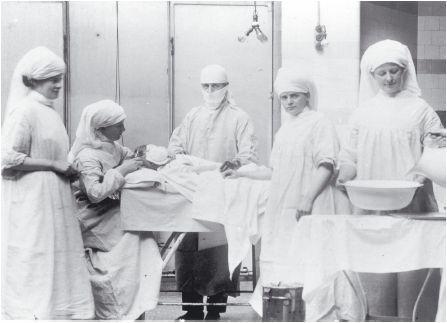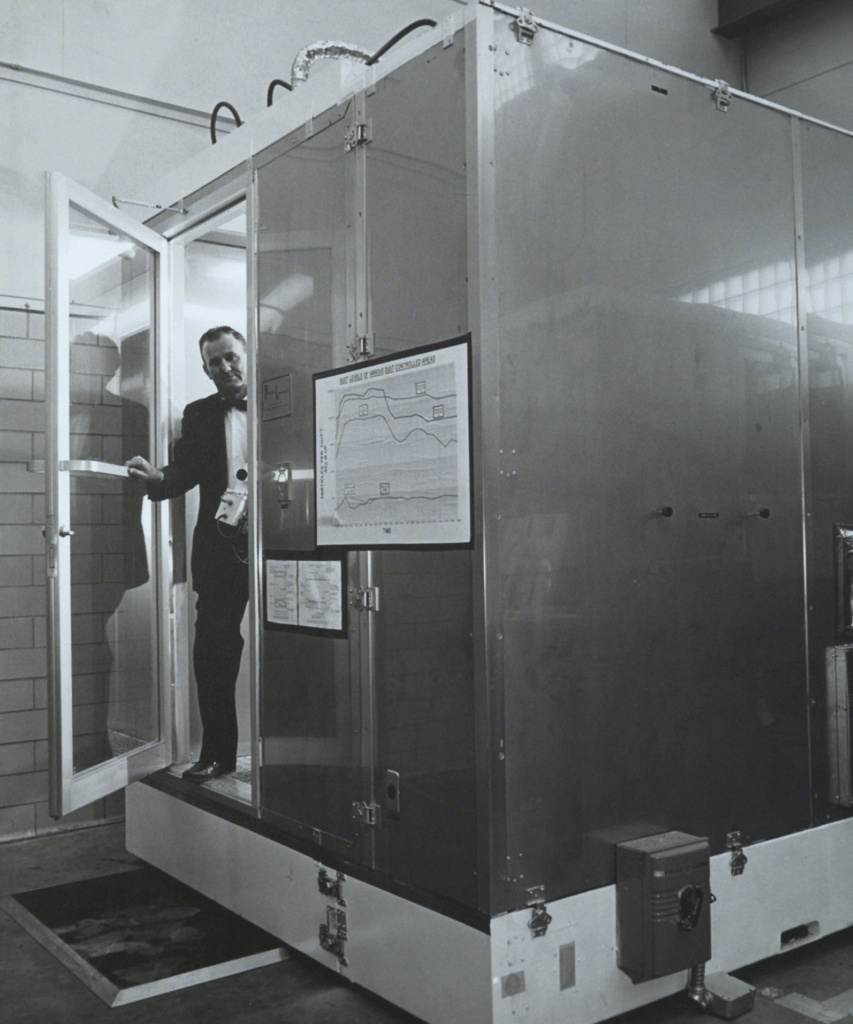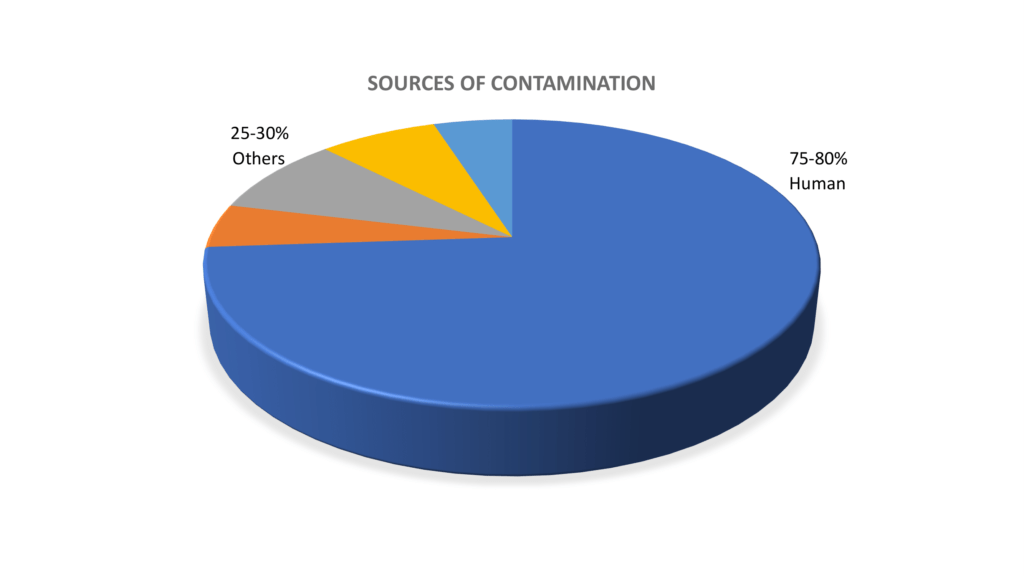The History of Cleanrooms

What do you think of when you hear the term cleanroom? Perhaps scientists dressed in full-body white cleanroom suits, sitting at stainless steel desks and working with microscopes. While those cleanrooms are characteristic of cleanrooms today, the evolution of the technology has been 60 years in the making. Past efforts at cleanliness and sterility often overlooked the removal of particles and contamination control. Over the years, many scientists and engineers have worked together to bring us the modern cleanroom. In this article, let’s take a brief look at the history of cleanroom technology.
What is a Cleanroom?
A cleanroom is a specially designed environment that maintains a minimal concentration of airborne particles. It is carefully isolated and rigorously monitored to prevent contamination and is regularly cleaned. These types of rooms are often necessary for scientific research and for the production of products which require dust-free manufacturing environments. The primary objective of a cleanroom is to prevent dust, airborne organisms, and other small particles from entering the room and contaminating the materials being handled within it.
The History of Cleanrooms

In an effort to regulate the air quality in areas where patients were situated, hospitals were the initial spaces to attempt such control. The manipulation of hospital space ventilation was observed in military hospitals in first-century Rome. Throughout time, hospitals evolved from vast, airy halls that were efficiently heated and ventilated. Florence Nightingale played a significant role in reducing the mortality rate of injured soldiers by emphasizing the necessity of meticulously clean and well-ventilated hospital rooms.
Louis Pasteur is renowned for his contributions to understanding the origins and prevention of illnesses. His medical breakthroughs offered compelling evidence for the germ theory of disease and its practical application in clinical medicine. Through experimentation, Pasteur demonstrated that microorganisms could not develop without contamination. He proved that in flasks that were sealed and sterilized, no growth occurred, whereas in flasks that were sterilized but left open, microorganisms could thrive.
The Rise of Surgery

One of the major reasons for regulating contamination was to prevent infection during surgery. Early leaders in this area included Joseph Lister, a British surgeon who advocated for antiseptic surgery and introduced disinfectants; William Keen, an American surgeon who focused on cleaning the surgical room; and Gustav Neuber, a German who designed a surgical suite in 1883 that could be thoroughly cleaned and featured non-porous surfaces, glass and metal furniture, and equipment for sterilizing the room.
Neuber’s model for surgery suites became popular and was adopted in many places. These early innovations also influenced manufacturers who were concerned about controlling contamination in their precision manufacturing operations.
In 1946, Robert Bourdillon and Dr. Leonard Colebrook demonstrated that bacterial contamination from the air could cause sepsis of burns and wounds, and that well-designed ventilation systems could help prevent this. In the 1950s, further research was conducted on the design of surgical suites, focusing on plenum ventilation and the use of inlet and outlet room conditions.
John Charnley, a surgeon specializing in hip replacement, was troubled by the high number of septic cases and postoperative infections, prompting him to investigate new methods of operating room ventilation. Building upon the work of Bourdillon, Colebrook, Blowers and Crew, Charnley and air-conditioning engineer James Howarth developed one of the first unidirectional airflow rooms that utilized sterile air supply and displacement ventilation.
The Second World War
During World War II, the demand for precise military parts led to an increased need for manufacturing environments that were free of contaminants. Before and during the war, precision bearings were utilized in gyroscopes and bomb sites. Even after the war, the U.S. military continued to develop advanced aircraft with sophisticated guidance systems and miniature components.
The first transistor was invented in 1947, and by the mid-1950s, The New York Times had identified “making things smaller” as a key aspect of improved aircraft performance. Two years later, Times magazine recognized miniaturization as essential to business growth, acknowledging that military needs had driven the trend. The magazine predicted that miniaturization would eventually become a part of civilian life, as pocket radios, small hearing aids, and other electronic devices had already decreased in size. In the future, even “giant electronic brains” would become smaller.
The Modern Cleanroom

Willis Whitfield, an American physicist and employee of the Sandia National Laboratories, is credited with inventing the modern cleanroom in 1960. Before Whitfield’s invention, cleanrooms had issues with particles and inconsistent airflows. However, Whitfield’s design incorporated a constant and well-filtered airflow to effectively eliminate impurities.
Today, Whitfield is credited as the inventor of the laminar-flow cleanroom model, a technology that revolutionized manufacturing in pharmaceuticals, made hospital operating rooms safer and advanced aerospace engineering.
Cleanroom Technology Today
Modern cleanrooms today are characterized by various features and standards, all in an effort to control contamination and promote sterility. Some of these features include:
1. High-Efficiency Particulate Air (HEPA) filtration:
Cleanrooms employ advanced air filtration systems using HEPA filters to remove particles as small as 0.5 microns. These filters help maintain a clean and particle-free environment.
2. Positive Pressure:
Cleanrooms are typically designed to maintain positive pressure, meaning that air flows out of the cleanroom when doors are opened. This prevents the entry of unfiltered air from outside and reduces the risk of contamination.

3. Controlled Airflows:
Cleanrooms utilize controlled airflows to direct air in a specific pattern, typically from clean to less clean areas. This helps to minimize the movement of contaminants and maintain a controlled environment. Approximately 75% of the sources of contamination in clean rooms are attributed to human beings, whereas the other 25% arise from other factors such as equipment, ventilation, and the structure of the room.

4. Airlock Chambers:
Cleanrooms often have airlock chambers at the entrance to control the ingress and egress of personnel and equipment. Airlock chambers act as a buffer zone, reducing the introduction of contaminants from outside into the cleanroom.
5. Cleanroom Garments and Equipment:
Personnel working in cleanrooms are required to wear specialized cleanroom garments, such as coveralls, hoods, masks, gloves, and shoe covers. These garments minimize the shedding of particles and help maintain cleanliness. Cleanroom equipment is also designed to minimize particle generation.
6. Flooring and wall materials:
Cleanrooms feature smooth and non-porous flooring and wall materials, such as epoxy or vinyl, that are easy to clean and do not generate particles. The materials used are resistant to chemicals and may have static dissipative properties to prevent electrostatic discharge.
7. Monitoring and Control Systems:
Cleanrooms are equipped with sophisticated monitoring and control systems to maintain environmental parameters within specified limits. These systems continuously monitor and regulate factors like temperature, humidity, air pressure, and particle counts to ensure compliance with cleanliness standards.
8. Cleanroom Lighting:
Cleanrooms have specialized lighting systems that are designed to minimize the generation of particles and provide uniform illumination. Lighting fixtures are typically sealed to prevent the accumulation of dust or other contaminants.
9. Material Pass-Through Systems:
Cleanrooms may have pass-through systems, such as air showers or material transfer chambers, to facilitate the transfer of materials and equipment into and out of the cleanroom while maintaining cleanliness. These systems remove particles from the surfaces of objects before they enter the cleanroom.
10. Cleanroom Design Standards:
Modern cleanrooms are designed and constructed following specific industry standards and guidelines, such as ISO 14644 or Federal Standard 209E, to ensure a controlled environment with defined cleanliness levels.
It’s important to note that cleanroom features may vary depending on the industry, application, and required cleanliness standards, including pharmaceuticals and nutraceuticals, semiconductors and electronics, medical device manufacturing, aerospace, cosmetics, pharmacies, and more. Learn more about the industries ACH Engineering serves through our cleanroom solutions.
GET IN TOUCH
Complete the form below to get in touch with our team.
